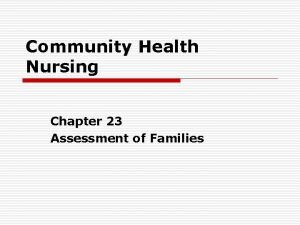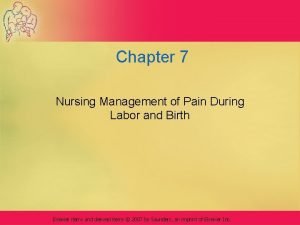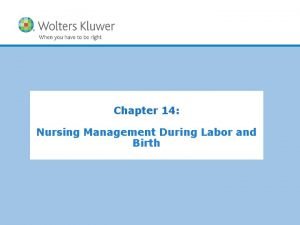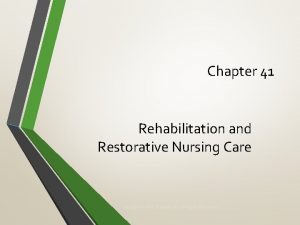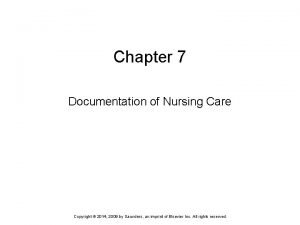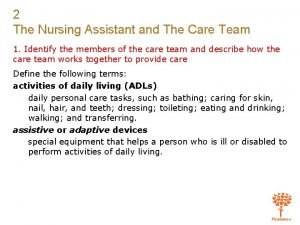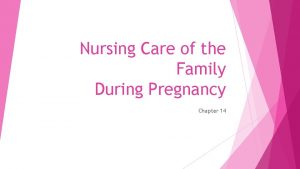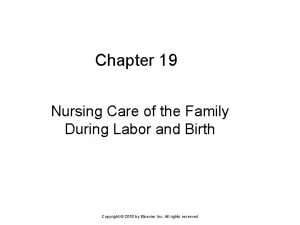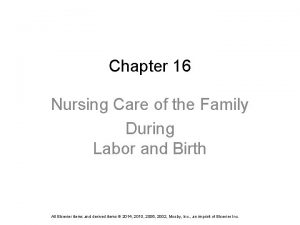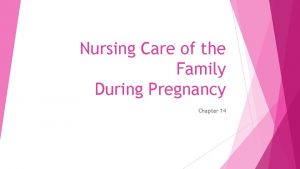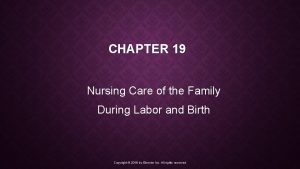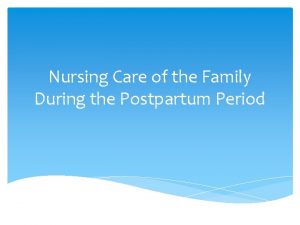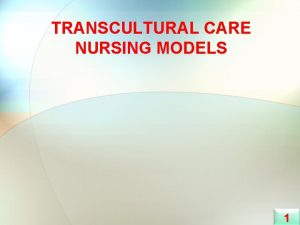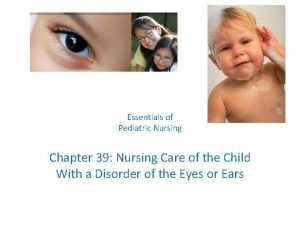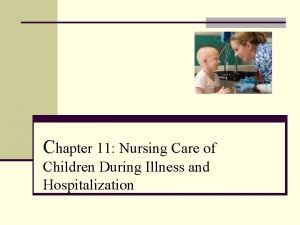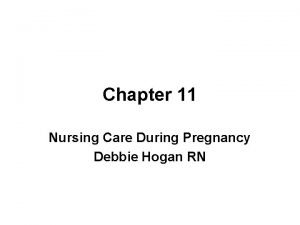Chapter 19 Nursing Care of the Family During














































- Slides: 46

Chapter 19 Nursing Care of the Family During Labor and Birth Copyright © 2016 by Elsevier Inc. All rights reserved.

Learning Objectives Review the data included in the initial assessment of the woman in labor. Describe the ongoing assessment of maternal progress during the first, second, third, and fourth stages of labor. Recognize the physical and psychosocial findings indicative of maternal progress during labor. Describe fetal assessment during labor. Copyright © 2016 by Elsevier Inc. All rights reserved. 2

Learning Objectives (Cont. ) Identify signs of developing complications during labor and birth. Incorporate evidence-based nursing interventions into a comprehensive plan of care relevant to each stage of labor. Recognize the importance of support (family, partner, doula, nurse) in fostering maternal confidence and facilitating the progress of labor and birth. Copyright © 2016 by Elsevier Inc. All rights reserved. 3

Learning Objectives (Cont. ) Analyze the influence of cultural and religious beliefs and practices on the process of labor and birth. Describe the role and responsibilities of the nurse during emergency childbirth. Evaluate the effect of perineal trauma on the woman’s reproductive and sexual health. Copyright © 2016 by Elsevier Inc. All rights reserved. 4

First Stage of Labor Begins with regular uterine contractions Ends with full cervical effacement and dilation Obstetric triage and EMTALA Prenatal data Ø The nurse reviews the prenatal record to identify the woman’s individual needs and risks Copyright © 2016 by Elsevier Inc. All rights reserved. 5

First Stage of Labor (Cont. ) Three phases of the first stage of labor Ø Latent phase (up to 3 cm of dilation) Ø Active phase (4 to 7 cm of dilation) Ø Transition phase (8 to 10 cm of dilation) Copyright © 2016 by Elsevier Inc. All rights reserved. 6

First Stage of Labor (Cont. ) Copyright © 2016 by Elsevier Inc. All rights reserved. 7

First Stage of Labor (Cont. ) Assessment and nursing diagnosis Ø Determination of whether the woman is in true labor or false labor • Contractions • Cervix • Fetus Ø Obstetric triage and EMTALA • Emergency Medical Treatment and Active Labor Act • A woman is considered to be in true labor until a qualified provider determines that she is not Copyright © 2016 by Elsevier Inc. All rights reserved. 8

First Stage of Labor (Cont. ) Copyright © 2016 by Elsevier Inc. All rights reserved. 9

First Stage of Labor (Cont. ) Assessment and nursing diagnosis Ø Admission to the labor unit data • Prenatal data • Interview Spontaneous rupture of membranes Bloody or pink show • Psychosocial factors Women with history of sexual abuse • Stress in labor Copyright © 2016 by Elsevier Inc. All rights reserved. 10

First Stage of Labor (Cont. ) Assessment and nursing diagnosis Admission data Cultural factors Woman may have a preconceived idea of the “right” way to behave Ø Culture and father participation Ø Non–Englishspeaking woman in labor Ø Copyright © 2016 by Elsevier Inc. All rights reserved. 11

First Stage of Labor (Cont. ) Assessment and nursing diagnosis Ø Physical examination • General systems assessment • Vital signs • Leopold maneuvers (abdominal palpation) • Assessment of FHR and pattern Copyright © 2016 by Elsevier Inc. All rights reserved. 12

First Stage of Labor (Cont. ) Assessment and nursing diagnosis Ø Physical examination • Assessment of uterine contractions Frequency Intensity – Mild, moderate, or strong Duration Resting tone • Vaginal examination Cervical effacement, dilation, fetal descent Copyright © 2016 by Elsevier Inc. All rights reserved. 13

First Stage of Labor (Cont. ) Assessment and nursing diagnosis Ø Laboratory and diagnostic tests • Analysis of urine specimen • Blood tests Complete blood count (CBC) Human immunodeficiency virus (HIV) status is undocumented Type and screen • Assessment of amniotic membranes and fluid • Other tests If GBS status unknown, rapid test can be performed • Signs of potential problems Copyright © 2016 by Elsevier Inc. All rights reserved. 14

First Stage of Labor (Cont. ) Plan of care and interventions Ø Standards of care Ø Physical nursing care during labor • General hygiene • Nutrient and fluid intake Oral intake Intravenous intake • Elimination Voiding: at least every 2 hours Catheterization Bowel elimination • Ambulation and positioning Copyright © 2016 by Elsevier Inc. All rights reserved. 15

Copyright © 2016 by Elsevier Inc. All rights reserved. 16

First Stage of Labor (Cont. ) Plan of care and interventions Supportive care during labor and birth: emotional support, physical care and comfort measures, and advice/information Ø Ø Ø Nurse Father or partner Doulas Grandparents Siblings during labor and birth Emergency interventions Copyright © 2016 by Elsevier Inc. All rights reserved. 17

Case Study A 22 -year-old woman presents to your maternity triage area. When you ask her reason for seeking care, she states, “I keep changing my underwear, but then it gets wet again. ” • • What other information do you need to gather? What can you do to figure out whether or not her bag of waters (BOW) is ruptured? Copyright © 2016 by Elsevier Inc. All rights reserved. 18

Case Study (Cont. ) Her bag of waters (BOW) is not broken. What should you do next? Your patient is 2 cm/50%/-2. What stage and phase of labor is she in? What is your next assessment/intervention? Copyright © 2016 by Elsevier Inc. All rights reserved. 19

Case Study (Cont. ) You receive orders to send the patient home. She states, “I can’t believe you’re sending me home when I’m so crampy! How am I supposed to sleep tonight? ” • What comfort measures will you suggest? • What teaching do you need to do? Copyright © 2016 by Elsevier Inc. All rights reserved. 20

Tools for Labor Copyright © 2016 by Elsevier Inc. All rights reserved. 21

Second Stage of Labor Infant is born Ø Ø Begins with full cervical dilation (10 cm) Complete effacement The “pushing” stage Ends with infant’s birth Copyright © 2016 by Elsevier Inc. All rights reserved. 22

Second Stage of Labor (Cont. ) Two phases Ø Latent: relatively calm with passive descent of baby through birth canal Ø Active: pushing and urge to bear down • Ferguson reflex: the urge to “bear down” Copyright © 2016 by Elsevier Inc. All rights reserved. 23

Care Management Preparing for birth Ø Maternal position: Supine, semirecumbent, or lithotomy positions are still widely used in Western societies despite evidence that an upright position shortens labor. Ø Bearing-down efforts • Valsalva maneuver Ø Fetal heart rate and pattern Ø Support of father or partner Ø Supplies, instruments, and equipment Copyright © 2016 by Elsevier Inc. All rights reserved. 24

Care Management (Cont. ) Birth in a delivery room or birthing room Lithotomy position Ø Crowning Ø Ritgen maneuver Ø Nuchal cord Ø Use of fundal pressure: contraindicated Immediate assessments and care of newborn Copyright © 2016 by Elsevier Inc. All rights reserved. 25

Care Management: Perineal Trauma Related to Childbirth Perineal lacerations Ø First degree: laceration that extends through the skin and vaginal mucous membrane but not the underlying fascia and muscle Ø Second degree: laceration that extends through the fascia and muscles of the perineal body, but not the anal sphincter Ø Third degree: laceration that involves the external anal sphincter Ø Fourth degree: laceration that extends completely through the rectal mucosa, disrupting both the external and internal anal sphincters Copyright © 2016 by Elsevier Inc. All rights reserved. 26

Copyright © 2016 by Elsevier Inc. All rights reserved. 27

Care Management: Perineal Trauma Related to Childbirth (Cont. ) Vaginal and urethral lacerations Cervical injuries Episiotomy An incision in the perineum used to enlarge the vaginal outlet Ø Has steadily declined in recent years due to a lack of sound, rigorous research to support its benefits Ø Copyright © 2016 by Elsevier Inc. All rights reserved. 28

Third Stage of Labor Birth of the baby until the placenta is expelled Ø The third stage is generally by far the shortest stage of labor Ø Usually expelled within 10 to 15 minutes after the birth; may be problematic if >30 minutes Ø Sudden gush of dark blood from the introitus Ø Apparent lengthening of the umbilical cord Ø Vaginal fullness Ø Placental examination and disposal • Cultural preferences Copyright © 2016 by Elsevier Inc. All rights reserved. 29

Copyright © 2016 by Elsevier Inc. All rights reserved. 30

Fourth Stage of Labor Care management Ø First 1 to 2 hours after birth Ø Assessment of maternal physical status • Physiologic changes to prepregnancy status Ø Signs of potential problems • Excessive blood loss • Alterations in vital signs and consciousness Ø Care of the new mother Ø Care of the family • Family-newborn relationships Copyright © 2016 by Elsevier Inc. All rights reserved. 31

Siblings Copyright © 2016 by Elsevier Inc. All rights reserved. 32

Postanesthesia Recovery The woman who has given birth by cesarean or has received regional anesthesia for a vaginal birth requires special attention during the recovery period Postanesthesia recovery (PAR) unit Copyright © 2016 by Elsevier Inc. All rights reserved. 33

Key Points The onset of labor may be difficult to determine for both nulliparous and multiparous women. The familiar environment of her home is most often the ideal place for a woman during the latent phase of the first stage of labor. The nurse assumes much of the responsibility for assessing the progress of labor and for keeping the nurse-midwife or physician informed about that progress and deviations from expected findings. Copyright © 2016 by Elsevier Inc. All rights reserved. 34

Key Points (Cont. ) The fetal heart rate and pattern reveal the fetal response to the stress of the labor process. Assessing the laboring woman’s urinary output and bladder is critical to ensure her progress and to prevent bladder injury. Copyright © 2016 by Elsevier Inc. All rights reserved. 35

Key Points (Cont. ) Regardless of the actual labor and birth experience, the woman’s or couple’s perception of the birth experience is most likely to be positive when events and performances are consistent with expectations, especially in terms of maintaining control and adequacy of pain relief. Copyright © 2016 by Elsevier Inc. All rights reserved. 36

Key Points (Cont. ) The woman’s level of anxiety may increase when she does not understand what is being said to her about her labor because of the medical terminology used or because of a language barrier. Coaching, emotional support, and comfort measures assist the woman to use her energy constructively in relaxing and working with the contractions. Copyright © 2016 by Elsevier Inc. All rights reserved. 37

Key Points (Cont. ) The progress of labor is enhanced when a woman changes her position frequently during the first stage of labor. Doulas provide a continuous, supportive presence during labor that can have a positive effect on the process of childbirth and its outcome. Copyright © 2016 by Elsevier Inc. All rights reserved. 38

Key Points (Cont. ) The cultural beliefs and practices of a woman and her significant others, including her partner, can have a profound influence on their approach to labor and birth. Siblings present for labor and birth need preparation and support for the event. Women with a history of sexual abuse often experience profound stress and anxiety during childbirth. Copyright © 2016 by Elsevier Inc. All rights reserved. 39

Key Points (Cont. ) Inability to palpate the cervix during vaginal examination indicates that complete effacement and full dilation have occurred, and they are the only certain, objective signs that the second stage has begun. Women may have an urge to bear down at various times during labor; for some it may be before the cervix is fully dilated, and for others it may not occur until the active phase of the second stage of labor. Copyright © 2016 by Elsevier Inc. All rights reserved. 40

Key Points (Cont. ) When encouraged to respond to the rhythmic nature of the second stage of labor, the woman normally changes body positions, bears down spontaneously, and vocalizes (open-glottis pushing) when she perceives the urge to push (Ferguson reflex). Copyright © 2016 by Elsevier Inc. All rights reserved. 41

Key Points (Cont. ) Women should bear down several times during a contraction using the open-glottis pushing method. They should avoid sustained closed-glottis pushing because this will inhibit oxygen transport to the fetus. Copyright © 2016 by Elsevier Inc. All rights reserved. 42

Key Points (Cont. ) Nurses can use the role of advocate to prevent routine use of episiotomy and reduce the incidence of lacerations by empowering women to take an active role in the birth and by educating health care providers about approaches to managing childbirth that reduce the incidence of perineal trauma. Copyright © 2016 by Elsevier Inc. All rights reserved. 43

Key Points (Cont. ) Objective signs indicate that the placenta has separated and is ready to be expelled; excessive traction (pulling) on the umbilical cord before the placenta has separated can result in maternal injury. Copyright © 2016 by Elsevier Inc. All rights reserved. 44

Key Points (Cont. ) During the fourth stage of labor, the woman’s fundal tone, lochial flow, and vital signs should be assessed frequently to ensure that she is physically recovering well after giving birth. Most parents and families enjoy being able to hold, explore, and examine the baby immediately after the birth. Copyright © 2016 by Elsevier Inc. All rights reserved. 45

Question 1. After an emergency birth, the nurse encourages the woman to breastfeed her newborn. The primary purpose of this activity is to: a. b. c. d. Facilitate maternal-newborn interaction Stimulate the uterus to contract Prevent neonatal hypoglycemia Initiate the lactation cycle Copyright © 2016 by Elsevier Inc. All rights reserved. 46
 Family care plan in community health nursing
Family care plan in community health nursing Nursing care plan for hoarding disorder
Nursing care plan for hoarding disorder Nursing intervention of cataract
Nursing intervention of cataract Levels of care primary secondary tertiary quaternary
Levels of care primary secondary tertiary quaternary Chapter 7 nursing management of pain during labor and birth
Chapter 7 nursing management of pain during labor and birth Chapter 14 nursing management during labor and birth
Chapter 14 nursing management during labor and birth Chapter 41 rehabilitation and restorative nursing care
Chapter 41 rehabilitation and restorative nursing care Nursing narrative note example
Nursing narrative note example The nursing assistant and the care team
The nursing assistant and the care team Describe the care team and the chain of command
Describe the care team and the chain of command Milk fact and opinion
Milk fact and opinion Hát kết hợp bộ gõ cơ thể
Hát kết hợp bộ gõ cơ thể Ng-html
Ng-html Bổ thể
Bổ thể Tỉ lệ cơ thể trẻ em
Tỉ lệ cơ thể trẻ em Gấu đi như thế nào
Gấu đi như thế nào Thang điểm glasgow
Thang điểm glasgow Chúa yêu trần thế alleluia
Chúa yêu trần thế alleluia Các môn thể thao bắt đầu bằng tiếng chạy
Các môn thể thao bắt đầu bằng tiếng chạy Thế nào là hệ số cao nhất
Thế nào là hệ số cao nhất Các châu lục và đại dương trên thế giới
Các châu lục và đại dương trên thế giới Công của trọng lực
Công của trọng lực Trời xanh đây là của chúng ta thể thơ
Trời xanh đây là của chúng ta thể thơ Mật thư anh em như thể tay chân
Mật thư anh em như thể tay chân 101012 bằng
101012 bằng Phản ứng thế ankan
Phản ứng thế ankan Các châu lục và đại dương trên thế giới
Các châu lục và đại dương trên thế giới Thơ thất ngôn tứ tuyệt đường luật
Thơ thất ngôn tứ tuyệt đường luật Quá trình desamine hóa có thể tạo ra
Quá trình desamine hóa có thể tạo ra Một số thể thơ truyền thống
Một số thể thơ truyền thống Cái miệng bé xinh thế chỉ nói điều hay thôi
Cái miệng bé xinh thế chỉ nói điều hay thôi Vẽ hình chiếu vuông góc của vật thể sau
Vẽ hình chiếu vuông góc của vật thể sau Thế nào là sự mỏi cơ
Thế nào là sự mỏi cơ đặc điểm cơ thể của người tối cổ
đặc điểm cơ thể của người tối cổ Ví dụ về giọng cùng tên
Ví dụ về giọng cùng tên Vẽ hình chiếu đứng bằng cạnh của vật thể
Vẽ hình chiếu đứng bằng cạnh của vật thể Phối cảnh
Phối cảnh Thẻ vin
Thẻ vin đại từ thay thế
đại từ thay thế điện thế nghỉ
điện thế nghỉ Tư thế ngồi viết
Tư thế ngồi viết Diễn thế sinh thái là
Diễn thế sinh thái là Dạng đột biến một nhiễm là
Dạng đột biến một nhiễm là Số nguyên là gì
Số nguyên là gì Tư thế ngồi viết
Tư thế ngồi viết Lời thề hippocrates
Lời thề hippocrates Thiếu nhi thế giới liên hoan
Thiếu nhi thế giới liên hoan
